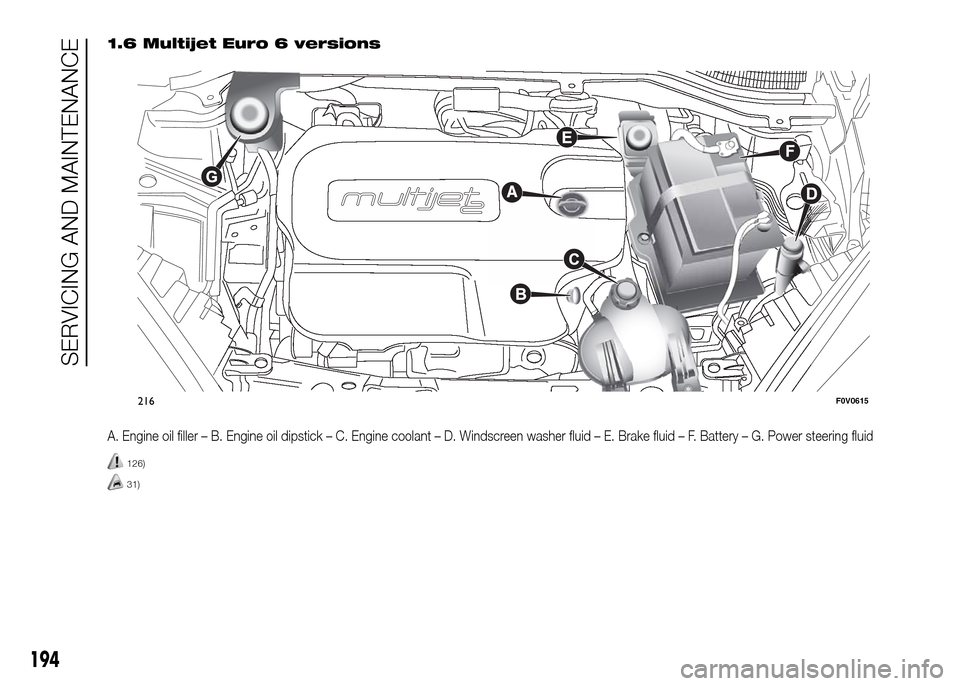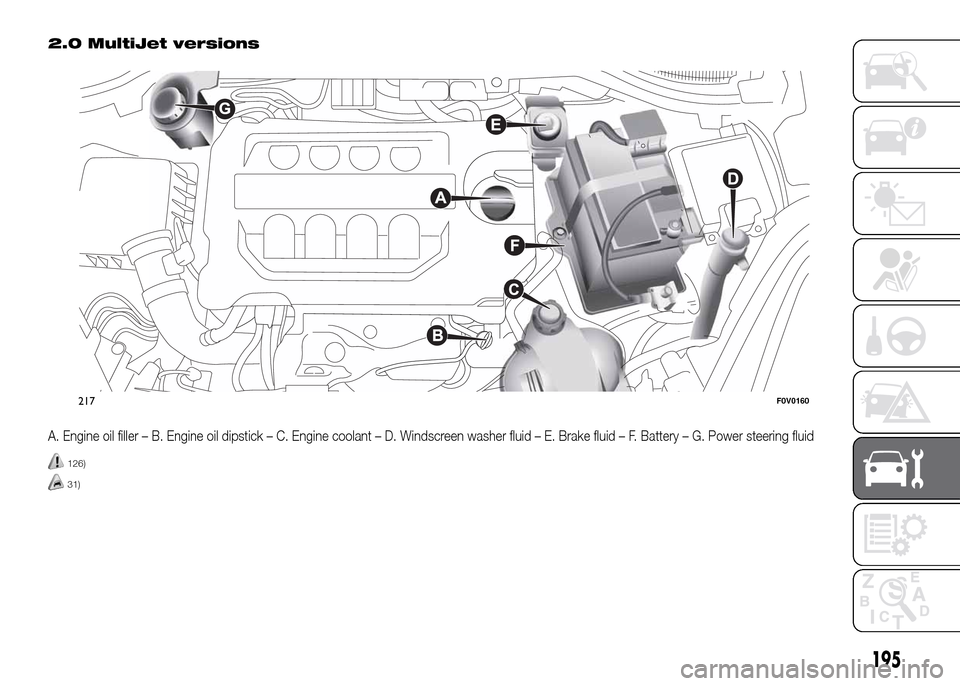2016 FIAT DOBLO PANORAMA battery
[x] Cancel search: batteryPage 198 of 323

1.6 Multijet Euro 6 versions
A. Engine oil filler – B. Engine oil dipstick – C. Engine coolant – D. Windscreen washer fluid – E. Brake fluid – F. Battery – G. Power steering fluid
126)
31)
216F0V0615
194
SERVICING AND MAINTENANCE
Page 199 of 323

2.0 MultiJet versions
A. Engine oil filler – B. Engine oil dipstick – C. Engine coolant – D. Windscreen washer fluid – E. Brake fluid – F. Battery – G. Power steering fluid
126)
31)
217F0V0160
195
Page 203 of 323

DIESEL FILTER
DRAINING
CONDENSATION
(MultiJet versions)
36)
IMPORTANT
36) The presence of water in the
supply circuit may cause severe
damage to the injection system
and irregular engine operation. If
the
warning light comes on,
go to a Fiat Dealership as soon as
possible to have the system bled.
If this problem is indicated
immediately after refuelling, water
may have entered the fuel tank.
In this case, immediately turn off
the engine and contact a Fiat
Dealership.
BATTERY
The battery is of the “limited
maintenance” type: under normal
conditions of use, the electrolyte does
not need topping up with distilled water.
It does, however, need to be checked
periodically at a Fiat Dealership or
by specialist personnel to make sure it
is working correctly.
133) 134)
REPLACING THE
BATTERY
If required, replace the battery with an
original spare part with the same
specifications.
If a battery with different specifications
is fitted, the service intervals given in
the “Scheduled Servicing Plan” will no
longer be valid.
Follow the battery manufacturer's
instructions for maintenance.
37) 38)
5)
135)
USEFUL TIPS FOR
EXTENDING BATTERY
LIFE
To avoid draining your battery and
make it last longer, observe the
following instructions:
❒when you park the vehicle, ensure
that the doors, tailgate and bonnet
are closed properly, to prevent any
roof lights from remaining on inside
the passenger's compartment;
❒switch off all roof lights inside the
vehicle: the vehicle is however
equipped with a system which
switches all internal lights off
automatically;
❒do not keep accessories (e.g. radio,
hazard warning lights, etc.) switched
on for a long time when the engine
is not running;
❒before performing any operation on
the electrical system, disconnect
the negative battery pole;
❒completely tighten the battery
terminals.
IMPORTANT If the charge level remains
under 50% for a long time, the battery
is damaged by sulphation, reducing
its capacity and efficiency at starting.
199
Page 204 of 323

The battery is also more prone to the
risk of freezing (already at temperatures
of -10°C). Refer to the paragraph
"Vehicle inactivity" in "Starting and
driving" if the vehicle is left parked for a
long time.
If, after buying the vehicle, you want to
install electric accessories which require
permanent electric supply (alarm, etc.)
contact a Fiat Dealership whose
qualified personnel, in addition to
suggesting the most suitable devices
from the Lineaccessori Fiat, will
evaluate the overall electric absorption,
checking whether the vehicle's
electrical system is capable of
withstanding the load required, or
whether it should be integrated with a
more powerful battery.
Since some of these devices continue
to consume electricity even when
the engine is off, they gradually run
down the battery.
WARNING
133) Battery fluid is poisonous and
corrosive. Avoid contact with
skin and eyes. Keep naked flames
or possible sources of sparks
away from the battery: risk
of explosion or fire.
134) Using the battery when the fluid
is too low can damage it
irreparably and generate a risk of
explosion.
135) When performing any operation
on the battery or near it, always
protect your eyes with special
goggles.
IMPORTANT
37) Incorrect assembly of electrical
and electronic devices may cause
severe damage to your vehicle.
Contact a Fiat Dealership if you
want to install accessories
(alarms, radiophone, etc.): they
will suggest the most suitable
devices and advise you if a higher
capacity battery needs to be
installed.
38) If the vehicle needs to be off the
road for a long period under
conditions of intense cold, remove
the battery and take it to a
heated location, otherwise it may
freeze.
200
SERVICING AND MAINTENANCE
Page 205 of 323

IMPORTANT
5) Batteries contain substances
which are very dangerous for the
environment. To replace your
battery, we recommend
contacting your Fiat Dealership to
dispose of your old battery in full
respect of the environment and in
compliance with all applicable
laws and regulations.
BATTERY
RECHARGING
IMPORTANT The battery recharging
procedure is given as information only.
This operation should be performed
at a Fiat Dealership.
Charging should be slow at a low
ampere rating for approximately 24
hours. Charging for a long time may
damage the battery.
To recharge, proceed as follows:
IN THE ABSENCE OF THE
START&STOP SYSTEM
❒disconnect the terminal from the
negative battery pole;
❒connect the charger cables to the
battery terminals, observing the
poles;
❒turn on the charger;
❒when you have finished, turn the
charger off before disconnecting
it from the battery;
❒reconnect the negative battery
terminal.WITH START&STOP
SYSTEM
Versions with dummy pole fig. 218
❒disconnect the quick release negative
terminal A from the dummy negative
terminal B; this is because a battery
status monitoring sensor D is fitted
on the negative battery terminal
C and should never be disconnected
except for when the battery is
actually replaced;
❒connect the positive cable of the
charger to the positive pole of the
battery and the negative cable to the
dummy negative terminal B;
❒turn on the charger;
❒after the recharge, turn the charger
off before disconnecting it from the
battery;
218F0V0381
201
Page 206 of 323

❒after disconnecting the battery
charger, reconnect the quick-release
negative terminal A to the dummy
pole B.
Versions without dummy pole fig.
219
To recharge proceed as follows, paying
great care:
❒press button A to detach connector
B from battery status monitoring
sensor C (this is located on the
negative pole of the battery itself);
❒connect the positive cable (+) of the
battery charger to the battery positive
terminal (+);
❒connect the negative cable (–) of the
battery charger to the pin D of the
negative battery terminal (–);
❒turn on the charger;❒when you have finished, turn the
charger off before disconnecting
it from the battery;
❒reconnect the connector B to the
sensor C of the battery.
136) 137)
WARNING
136) Battery fluid is poisonous and
corrosive: avoid contact with
your skin and eyes. The battery
recharging operation must be
performed in a ventilated place,
away from naked flames or
possible sources of sparks to
avoid the risk of explosion and
fire.
137) Don't try to recharge a frozen
battery: it must be thawed first,
otherwise it may explode. If the
battery was frozen, have it
inspected by specialised
personnel before recharging to
check that the internal elements
are not damaged and that the
casing is not cracked, which
causes the risk of leakage
of poisonous, corrosive acid.
WINDSCREEN/REAR
WINDOW WIPER
(for versions/markets, where provided)
BLADES
Periodically clean the rubber part using
special products; TUTELA
PROFESSIONAL SC 35 is
recommended.
Replace the blades if the rubber edge is
deformed or worn. In any case, it is
advisable to replace them
approximately once a year.
A few simple precautions can reduce
the possibility of damage to the blades:
❒if the temperature falls below zero,
make sure that ice has not frozen
the rubber against the glass. Use a
de-icing product to release it if
required;
❒remove any snow from the glass: in
addition to protecting the blades,
this prevents effort on the motor and
overheating;
❒do not operate the windscreen and
rear window wipers on dry glass.
138)
219F0V0380
202
SERVICING AND MAINTENANCE
Page 210 of 323

PROLONGED
VEHICLE INACTIVITY
If the vehicle needs to be off the road
for longer than one month, the following
precautions must be taken:
❒park the vehicle indoors in a dry and,
if possible, well-ventilated place;
❒engage a gear and check that the
handbrake is not engaged;
❒disconnect the negative terminal from
the battery pole (see paragraph
“Vehicle inactivity” in the "Dashboard
and controls" chapter) and check
the charge conditions (see paragraph
“Battery” in the “Care and
maintenance” chapter);
❒clean and protect the painted parts
using protective wax;
❒clean and protect the shiny metal
parts using special compounds
available commercially;
❒sprinkle talcum powder on the
windscreen and rear window wiper
rubber blades and lift them off the
glass;
❒slightly open the windows;❒cover the vehicle with a piece of
fabric or perforated plastic sheet. Do
not use compact plastic tarpaulins,
which prevent humidity from
evaporating from the surface of the
vehicle;
❒inflate tyres to +0.5 bar above the
standard specified pressure and
check it at intervals;
❒do not drain the engine cooling
system.
BODYWORK
PROTECTION AGAINST
ATMOSPHERIC AGENTS
The main causes of corrosion are the
following:
❒atmospheric pollution;
❒salty air and humidity (coastal areas,
or hot humid climates);
❒seasonal environmental conditions.
The abrasive action of wind-borne
atmospheric dust and sand, as well as
mud and gravel raised by other cars
is also not to be underestimated.
On your vehicle, Fiat has implemented
the best manufacturing technologies
to effectively protect the bodywork
against corrosion.
These include:
❒painting products and systems which
give the vehicle particular resistance
to corrosion and abrasion;
❒use of galvanised (or pretreated)
sheet metal, with high resistance
to corrosion;
❒spraying the underbody, engine
compartment, wheelhouse internal
parts and other parts with highly
protective wax products;
206
SERVICING AND MAINTENANCE
Page 319 of 323

INDEX
A
BS .............................................. 106
Accessories purchased by the
owner .......................................... 5
Active safety systems ..................... 106
Advice for preserving the
bodywork..................................... 207
Air cleaner/pollen filter .................... 198
Ashtray .......................................... 64
ASR system ................................... 109
Automatic climate control
system ......................................... 49
Battery .......................................... 199
Battery recharging.......................... 201
Blades ........................................... 202
Bodywork ...................................... 206
Bodywork paint identification
plate............................................. 212
Bodywork version .......................... 214
Bonnet ........................................... 57
Boot............................................... 58
Brake fluid ...................................... 196
Brakes
– specifications ............................ 221
Bump starting ................................ 174
Carrying children safely ................. 115
– child restraint systems ............... 120
Changing a wheel .......................... 166
Chassis marking ............................ 212Child restraint systems
(compliance for use) ..................... 117
Child safety device ......................... 20
Cigar lighter.................................... 64
CO2 emissions............................... 290
Control panel and on-board
instruments .................................. 72
Controls ......................................... 56
Cruise Control ................................ 141
Daytime running lights .................. 34
Dead lock ...................................... 15
Demanding vehicle use .................. 188
Diesel filter ..................................... 199
Diffusers ......................................... 42
Digital display ................................. 75
– Control buttons ......................... 75
– Set-up menu ............................. 75
Dimensions .................................... 231
Dipped headlights .................... 34-155
Direction indicators ................... 34-156
Door mirrors ................................... 32
Doors ............................................. 19
Draining condensation (MultiJet
versions) ...................................... 199
Driver side armrest ......................... 62
Driver's side front airbag ................ 122
Electric windows ........................... 55
– Initialisation................................ 56
Emergency starting ................ 131-174
Engine codes ................................. 214Engine compartment control unit
fuses ............................................ 161
Engine compartment...................... 189
Engine coolant ............................... 196
Engine
– technical specifications.............. 216
Engine marking .............................. 213
Engine oil ....................................... 196
EOBD system ................................ 87
ESC system ................................... 108
Exterior lights ................................. 34
Fastening the tow hook................. 176
Fiat CODE system.......................... 18
Fix&Go automatic quick tyre
repair kit ....................................... 170
Fluids and lubricants ...................... 266
Fog lights ................................. 56-156
Follow Me Home device ................. 35
Follow Me Home ............................ 35
Front airbags .................................. 121
Front bench ................................... 27
Front light clusters .......................... 155
Front roof light ................................ 158
Fuel consumption .......................... 270
Fuel cut-off system......................... 175
Fuses on compartment wired
casing .......................................... 162
Glove compartment ...................... 62
Handbrake.................................... 132